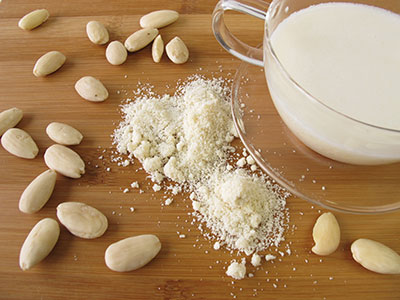
A different kind of dairy
June 24, 2013
By Michelle Brisebois
Got milk? The answer is yes, but not in its traditional form.
Got milk? The answer is yes, but not in its traditional form. In the eternal search for gastric nirvana, dairy is often one of the first food groups to go due to allergies, an inability to digest lactose, or the need to avoid dairy to follow a vegan lifestyle. When you put all of these reasons together, it adds up to a rapidly increasing demand for alternative milk products. Finding the right dairy substitute can be daunting, especially if you’re a baker relying on milk as a staple for your products.
 |
|
| Almond has the second highest sales for alternative milk with a toasted, neutral flavouring, says chef John Csukor, a culinary expert on almond.
|
All dairy dietary issues are not created equal. A milk allergy is defined as an immune response to one of the milk proteins. Lactose intolerance is caused by not having enough lactase, which is an enzyme that aids in the digestion of lactose (a milk sugar). Since people tend to self-diagnose their various health and weight issues, milk becomes a common preliminary place for consumers to start making substitutions. The nation’s numbers are showing a decline in liquid milk consumption. In 1992, Canadians consumed an average 92.6 litres of milk according to Statistics Canada. By 2011, that number had dropped to 78.7 litres.
Most people are choosing plant-based milks as a substitute. Each one has its own unique flavour and character. Soymilk, made from soybeans, is most popular. Following in consumer recognition and consumption are almond milk, rice milk and coconut milk, in that order. If a recipe calls for low-fat milk – such as cakes and scones – you can substitute a plant-based milk quite easily at the same ratio as indicated in the recipe. It’s sometimes suggested one avoid the coconut milk-based substitutes for baking because they are high in saturated fat (and they don’t always work well in cooking and baking), and hemp milk because the earthy hemp flavour can be strong and it can overpower your recipes.
“When it comes to making desserts like pudding, there are a couple things to remember,” advises chef John Csukor at KOR Food Innovation, who is the Almond Board of California's resident almond culinary expert. “First off, almond milk cannot be boiled or it will break when cooled. To make pudding recipes such as pastry cream, try adding an extra egg yolk or starch to your recipe and allow the almond milk to reach a low, gentle simmer.”
It is a general guideline to not use milk when making cheesecake since it is made out of cheese, but for a non-dairy cheesecake, use dairy-free cream cheese, Csukor advises. From there, incorporate almond milk into the filling depending on the topping of choice.
When making desserts such as icings and ganache, the ratio is 1:1 with no change in the process, but when specifically making chocolate ganache use almond milk as the dairy substitute.
“The chocolate taste is enhanced by the subtle rich toasted almond flavour,” he adds. “As for frozen desserts, almond milk is an excellent base for ice creams and gelato as it complements the spices without being overpowering.”
He also suggests “bakers try using blanched almonds that have been soaked and emulsified with water to add moisture to some of your baked goods, similar to when some bakers incorporate mayonnaise into their recipes.”
If you serve specialty coffees, some plant-based milks make more foam than others. Foam is what separates a cappuccino from a latte; while the foam-to-milk ratios can vary, it’s generally agreed that a cappuccino is mostly foam whereas a latte is mostly made up of milk. Air bubbles that are frothed into the milk and stay put create foam. It’s the protein in milk that keeps the bubbles in place. Glycerol, a substance found in milk fat, causes the bubbles to pop and fresh milk has less free glycerol than milk that’s been in the fridge a while, which is why fresh milk foams better. Soymilk is often the best option for specialty coffees requiring stable foam. The fat content of soymilk makes it easier to foam and coaxing it with a few drops of flavourless oil will help it develop.
Almond milk can be used in a variety of beverages. From a nutritional standpoint, almond milk has no cholesterol, less fat, and fewer calories and carbohydrates than some other richer, creamier options consumers may use. When it comes to making gourmet coffees, almond milk can be frothed; however, the foam may fade more quickly than some other dairy options. Rice and hemp milks tend not to foam as nicely as soymilk does either.
One-third of people are lactose intolerant, with many more voluntarily seeking out non-dairy options. Create some dairy-free offerings for your menu and then promote them heavily . . . and make sure you milk it.
Michelle Brisebois is a marketing professional with experience in the food, pharmaceutical, financial services and wine industries. She specializes in retail brand strategies.
Print this page
Leave a Reply